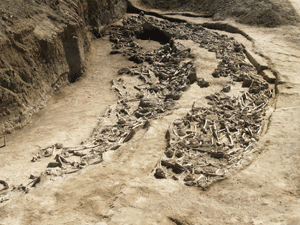
(Courtesy Lence Jovanova)
The Roman colony of Scupi in northern Macedonia
is the most thoroughly excavated ancient site in the
country. Thus archaeologists were shocked when, in
fall 2011, they uncovered a completely unknown mass grave
on the periphery of the settlement's largest necropolis. By
the time they had to stop digging in mid-December due to
weather, project leader Lence Jovanova and her team had
identified at least 180 adult male skeletons that had been
tossed into a pit a foot and a half deep. Many had been
decapitated and most had their arms bound behind their
backs. Some of the bones show the marks of extreme violence
such as cutting and breakage. "It was a terrible sight,
like a modern massacre," says Jovanova. When archaeologist
Phil Freeman of the University of Liverpool, who specializes
in Roman battlefield archaeology, saw images of the excavation,
he says his jaw dropped. "The only thing I can think
of that is comparable to this is the Vilnius, Lithuania, mass
grave from 1812," he remarks, referring to the find 10 years
ago of 2,000 well-preserved corpses of French soldiers killed
during Napoleon's retreat from Russia ("Digging Napoleon's
Dead," September/October 2002). Jovanova says she can
find no comparisons for the site.
Why the men were killed remains a mystery. "All we
know is that they died violent deaths. Maybe they were executed.
It could have been a war or conflict," Jovanova says,
adding that she thinks that whatever did happen occurred
near the town, explaining why the victims were buried in
the main necropolis. Freeman believes that a mass military
execution is the likely scenario. With civil executions, the
victims' heads were often placed at the corpses' feet, he
explains. None of the Scupi skeletons were found this way.
Freeman further notes that the grave is not likely the
result of a battlefield event. The repeated evidence for
decapitation suggests the victims were killed after, not
during, battle. It is possible that the mass killing could be
linked to the conflicts destabilizing the Roman Empire during
the late third to early fourth centuries A.D., according to
Jovanova. Freeman agrees that the empire's intense political
instability, as different armed factions fought to bring their
preferred leader to the emperor's throne, could be tied to
the grave in some way. "Our natural tendency is to see the
archaeology as simply adjunct to the historical sources,"
Freeman says. "Since something dates to the first century, for
example, it has to fit into a known first-century event. That
assumption is made time and time again." But he calls it "a
dangerous game" to attempt to match such dramatic finds
with known military episodes. Although this may come as a
surprise to many, Freeman stresses that there is still a great
deal of Roman history that is unknown.
 Feature: Burial Customs
Feature: Burial Customs
Matthew Brunwasser is a freelance writer living in Istanbul.

